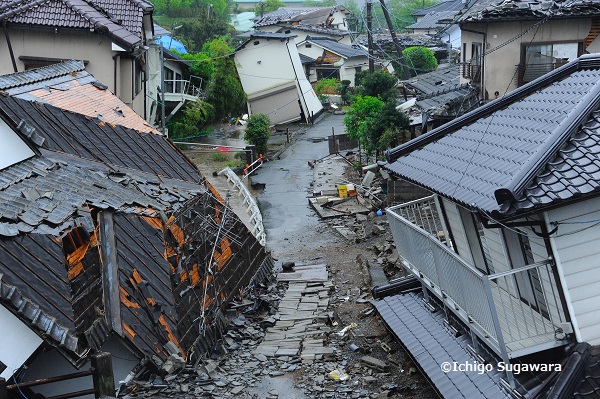The Japanese Red Cross Society's Response to the 2016 Kumamoto Earthquake Disaster (as of 2 May)
1. Details of the Response of the Japanese Red Cross Society
(1) Medical Emergency Team Operation (as of 10.00pm, 1 May)
| Status | The number of the medical emergency team | Active areas | Involving prefectural chapters |
| Ongoing Operation | 32 | Kami-mashiki, Aso, and Kumamoto | Hokkaido, Miyagi, Yamagata, Fukushima, Saitama, Chiba, Tokyo, Kanagawa, Toyama, Fukui, Aichi, Shiga, Kyoto, Osaka, Hyogo, Nara, Wakayama, Tottori, Okayama, Hiroshima, Yamaguchi, Tokushima, Ehime, Kochi, Fukuoka, Oita, Kagoshima, and Okinawa |
NB: The Japanese Red Cross Society is dispatching several dERUs*, and a number of medical staff of Japanese Red Cross Hospitals are participating in DMAT.**
*dERU: Domestic Emergency Response Unit (dERU) is a mobile medical unit. One "Temporary Clinic / Hospital Unit" is comprised of a truck with automatic lift and lowering capability, the container, the standardised equipment kept inside the vehicle, and the 14 trained professionals who work inside. There are 2 medical doctors, 2 head nurses, 4 regular nurses, 1 maternity nurse, 1 pharmacist, and 4 administrators, in general.
** DMAT: Japan Disaster Medical Assistance Team (DMAT) is a group of professional medical personnel and administrators organised by the Ministry of Health, Labour and Welfare of Japan.

![13124697_1082774088461738_8476699638720220484_n[1].jpg](/english/relief/img/13124697_1082774088461738_8476699638720220484_n%5B1%5D.jpg)
Providing medical session for preventing deep vein thrombosis (DVT) symptom, so-called 'economy-class syndrome'. Significant aspect of the Kumamoto Earthquake Disaster is that tremors have been occurring repeatedly; and therefore, many people are sleeping at their cars - small space - due to the fear of possible collapse of their houses with sudden quakes. This situation causes a number of people suffering from DVT.

Set-up play spaces in a tent of a dERU for the evacuated children
(2) Japanese Red Cross Society Disaster Medical Co-ordinate Team
The Japanese Red Cross Society has dispatched the Japanese Red Cross Society Disaster Medical Co-ordinate Team to the disaster affected zone. The team is a group of professional, who plans and coordinates an emergency medical relief operation, and gives advice to the relevant relief actors and organisations.
(3) Psychosocial Support
| Status | The number of the care staff |
| Ongoing Operation | 7 |
(4) Medical Personnel: Support Staff to Kumamoto Red Cross Hospital from Other Red Cross Hospitals in Japan
| Status | The number of the medical personnel (doctors, nurses, and administrators) |
| Ongoing Operation | 49 |
(5) The Headquarters and Chapters of the Japanese Red Cross Society
The Headquarters in Tokyo and chapters throughout Japan have been active, operating on 24-hour schedules, since major quake hit Kumamoto on 14 April. Fifteen Japanese Red Cross officials have been deployed to Kumamoto.
(6) Distribution of the Number of the Relief Supplies to the Affected People in the Evacuation Centres, etc.
| Blankets | Sleeping mats with pillows | Emergency kits* | Tarpaulins (waterproof plastic sheets) |
| 18,980 | 6,401 | 654 | 11,200 |
* Mobile radio, electric torch, toothbrush, towel, wet tissue, work gloves, ointment, bandage, etc.
Sleeping mats with pillows

(7) Japanese Red Cross Society Volunteers
a. Kumamoto Chapter
| Date | Activities |
| 15 April | Transported aid supplies |
| 16 April | Being dispatched to medical relief teams |
| 17 April | Established the Kumamoto Chapter Disaster Volunteer Centre |
| Since 22 April | Collected information with the Mashiki-town Disaster Volunteer Centre |
b. Other Chapters of the Japanese Red Cross Society
The Japanese Red Cross Society volunteers have been carrying out operations since 15 April. Some of them are also working for the Mashiki-town Disaster Volunteer Centre.
(8) International Donation
The Japanese Red Cross Society accepts international cash contributions to its humanitarian assistance for the people affected by the earthquakes which hit Kumamoto. Please see the following link:
http://www.jrc.or.jp/english/relief/160420_004225.html
2. Outline of the Disaster (Source: the Japan Meteorological Agency)
Location: Kumamoto Prefecture, Japan
(1) Major Quakes:
14 April 9.26pm, 6.5 Magnitude
15 April 0.03am, 6.4 Magnitude
16 April 1.25am, 7.3 Magnitude
(2) Magnitude of Earthquake: 7.3 (estimated)
Time of earthquake: 1.25am, 16 April, 2016
Epicentre: Kumamoto area of Kumamoto Prefecture (32.8°N, 130.8°E)
Depth of hypocentre: 10km (tentative)

3. Disaster Relief Act
Disaster Relief Act has been adapted.
4. Damages
Human Casualties
| Prefecture | Death | Serious injuries |
| Kumamoto | 66 | 333 |
| Oita | 4 | |
| Saga | 4 | |
| Miyazaki | 3 | |
| Fukuoka | 1 | |
| TOTAL | 66 | 345 |
(as of 8.00am 30 April by the Fire and Disaster Management Agency: FDMA)
Structural Damages
It has been estimated that the total number of 10,236 up to 10,336 residential houses were damages, which include total collapse. (Source: Kumamoto Disaster Prevention Measures Head Office)

5. The Situation of the Evacuation Centre
(as of 8.00am 30 April by the Fire and Disaster Management Agency: FDMA)
| Prefecture | The number of the evacuation centre | The number of the evacuee | As of Date | As of Time |
| Kumamoto | 444 | 30,629 | 29 April | 1.30pm |
| Oita | 8 | 214 | 29 April | 7.00pm |
| TOTAL | 452 | 30,843 |




